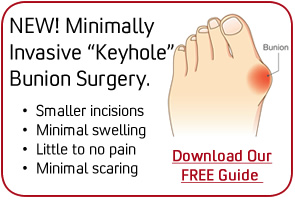|
Hallux Varus
Hallux varus is a condition in which the great toe is pointing away from the 2nd toe. This can be considered the opposite of a hallux valgus or bunion deformity. In contrast to a bunion, however, the 1st metatarsal remains in its anatomical position while the great toe is deviated towards the middle of the body. Hallux varus most commonly occurs as a complication from bunion surgery. However, other causes can lead to this condition. These include: congenital deformity, tight or short abductor hallucis tendon, trauma, absence or surgical removal of the fibular sesamoid. The presenting symptom is most commonly pain. This can occur from the toe rubbing against the side of the shoe. Occasionally, this deformity can also lead to problems with ingrown nails as the nail fold is pushed into the nail border by the shoe. Diagnosis The diagnosis of hallux varus is fairly simple as the great toe can be seen to be deviated away from the 2nd toe. A careful history will often assist in determining the cause of the hallux varus. This is a condition that is not uncommon in children. A congenital deformity is most commonly the result of a tight or short abductor hallucis tendon. This tendon attaches to the side of the great toe. It opposes the pull of the adductor hallucis tendon that is on the opposite side of the great toe. By working together, these tendons assist in keeping the great toe straight. However, when the abductor tendon is tight, it will overpower the adductor tendon and pull the toe toward the midline of the body. The diagnosis can be made by attempting to reduce this deformity manually and feeling the tightness of the tendon. Trauma should also be considered as a possible cause of this condition. Injury to the great toe, which disrupts the mechanical balance of the tendons, can lead to this abnormal deviation of the toe. A careful history and clinical examination will often lead the physician to the correct cause. The fibular sesamoid is key structure in the development of a hallux varus. Because the adductor hallucis tendon attaches to this structure, any disruption of the fibular sesamoid can lead to a hallux varus. This can result from a condition referred to as agenesis of the fibular sesamoid. In this condition, the fibular sesamoid fails to develop from birth. Therefore the normal attachment of the adductor tendon is absent, causing the abductor tendon to pull the toe medially. Trauma to the sesamoid which disrupts this attachment can also lead to a hallux varus (see sesamoiditis). One of the more common etiologies however is when a fractured fibular sesamoid needs to be removed due to non-union and chronic pain. Surgically the attachment of the adductor tendon is disrupted when the fibular sesamoid is removed. The most common cause of a hallux varus, however, is following a bunionectomy. This fortunately is not a common complication of bunion surgery. This most commonly develops as a result of: 1) aggressive removal of the "bump" on the side of the great toe; 2) removal of the fibular sesamoid; 3) over tightening of the soft tissues medially as one corrects the deviation of the toe. Treatment Treatment of this condition is dependent on the cause. In children with a tight adductor tendon, treatment should be focused on stretching this tendon. This can be done with stretching exercises, splinting of the toe and straight or reversed last shoes. If conservative care fails to correct the deformity, surgery may be necessary. This is performed by selective sectioning of the tendon with a small incision on the side of the toe. The toe is then splinted in a neutral or straight position. When hallux varus develops as a complication from bunion surgery, additional corrective surgery is often necessary. The extent of the surgery will depend on the degree of the deformity and the length of time the hallux varus has been present. The earlier the hallux varus is discovered and treated, the less complicated the corrective surgery. Article provided by PodiatryNetwork.com.
|










